Fault Code 56: Input Shaft Speed Sensor
J1587 MID 130 PID 161 FMI 2, 3, 4, 5
J1939 SA 3 SPN 161 FMI 2, 3, 4, 5
Overview
The UltraShift PLUS transmission is equipped with electronic speed sensors. The Input Shaft, Main Shaft and Output Shaft Speed Sensors are used to calculate gear ratios within the transmission. The Input Shaft Speed Sensor measures the rotational speed of the Input Shaft, taken from the upper countershaft drive gear. The Main Shaft Speed Sensor measures the rotational speed of the transmission gearing exiting the main case, taken from the auxiliary upper countershaft gear. The Output Shaft Speed Sensor measures the rotational speed of the output shaft taken from the Output Shaft Tone Wheel. The Transmission Electronic Control Unit (TECU) compares these speeds to calculate the gear ratios of the main case, auxiliary case and overall transmission.
The Input Shaft Speed Sensor transmits a voltage signal to the TECU based on the rotational speed of the Input Shaft entering the transmission main case. The TECU compares Input Shaft Speed to Main Shaft Speed to confirm the gear ratio of the main case and compares Input Shaft Speed to Output Shaft Speed to confirm the overall transmission gear ratio.
Fault Code 56 indicates an electrical fault within the Input Shaft Speed Sensor circuit or a speed value that is inconsistent with the calculated gear ratios.
Detection
The TECU monitors the Input Shaft Speed Sensor signal and compares the sensor readings with the Main Shaft Speed Sensor and the Output Shaft Speed Sensor to determine sensor validity. The TECU also monitors the Input Shaft Speed Sensor electrical circuit for any shorts to power, ground or open circuits.
Conditions to Set Fault Code Active
The system can detect Input Shaft Speed Sensor faults when one of the following conditions is present for 1 second or longer:
FMI 2 – Data Erratic: TECU detects data being reported from the Input Shaft Speed Sensor does not match the current gear ratio in comparison with other sensors.
FMI 3 – Voltage Above Normal or Shorted High: TECU detects a short to power in the circuit.
FMI 4 – Voltage Below Normal or Shorted Low: TECU detects a short to ground in the circuit.
FMI 5 – Current Below Normal or Open Circuit: TECU detects an open circuit or the Input Shaft Speed Sensor has high resistance.
Fallback
All FMIs
- “F” flashes in gear display.
- Service light flashes (if equipped).
- Transmission will not engage a gear from neutral.
- Transmission may be limited to down shifts only.
- Transmission operates as normal until neutral gear selection is attained. Once in neutral, the transmission will not engage a start gear.
Conditions to Set Fault Code Inactive
All FMIs: TECU receives a valid signal from the Input Shaft Speed Sensor and detects no electrical open or short circuits for 2 seconds.
Possible Causes
All FMIs
- Transmission Harness
- Bent, spread, corroded or loose terminals
- Wiring shorted to ground, shorted to power or open
- Input Shaft Speed Sensor
- Internal failure
- Physical damage
- Mechanical Transmission
- Internal transmission wear or damage
Component Identification
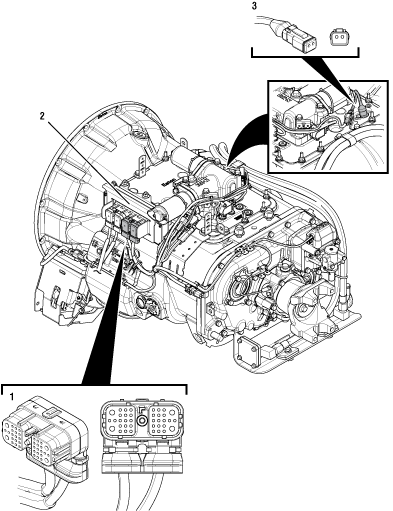 |
1. 38-Way Transmission Harness Connector 2. Transmission Electronic Control Unit (TECU) 3. 2-Way Input Shaft Speed Sensor |
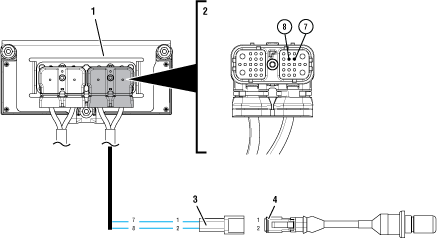 |
1. Transmission Electronic Control Unit (TECU) 2. 38-Way Transmission Harness Connector 3. 2-Way Input Shaft Speed Sensor Connector 4. 2-Way Input Shaft Speed Sensor |
 |
Fault Code 56 Troubleshooting
Record the transmission fault codes, FMIs, occurrences, and timestamps from the Service Activity Report created during the Diagnostic Procedure.
If Fault Code 56 is Active with FMI 3, 4, or 5, Go to Step C
If Fault Code 56 is Active or Inactive with FMI 2, Go to Step F
If Fault Code 56 is Inactive with FMI 3, 4, or 5, Go to Step B
Set parking brake and chock wheels.
Place transmission in PD Mode. See more about Product Diagnostic (PD) Mode.
Note: Transmission does not enter PD Mode when Active fault codes exist.

Wiggle wiring and connections of the Transmission Harness from the Input Shaft Speed Sensor to the TECU. Look for signs of pinched or chafed wiring. Verify all connections are clean and tight.
Verify Input Shaft Speed Sensor is properly installed and secured, not damaged or corroded within the Shift Bar Housing.
Exit PD Mode by powering down.
Notice
If any fault became Active while wiggling the Transmission Harness, replace Transmission Harness. Go to Step V
If any fault became Active while wiggling the Input Shaft Speed Sensor, replace Input Shaft Speed Sensor. Go to Step V
If no fault is found, replace Transmission Harness and Input Shaft Speed Sensor. Go to Step V
Key off.
Disconnect 38-Way Transmission Harness Connector from the TECU.
Inspect 38-Way Connector body for damage and bent, spread, corroded or loose terminals.
Measure resistance between 38-Way Transmission Harness Connector Pin 7 and Pin 8. Record reading(s) in table.
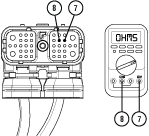
Measure resistance between 38-Way Transmission Harness Connector Pin 7 and ground. Record reading(s) in table.
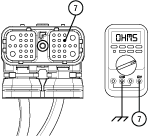
After reading is taken, reconnect 38-Way Transmission Harness Connector at the TECU.
Compare reading(s) in table.
If readings are in range, Go to Step D
If readings are out of range, Go to Step E
| Pins | Range | Reading(s) |
|---|---|---|
| 7 to 8 | 2.0k–4.5k ohms | |
| 7 to Ground | Open Circuit (OL) |
Key off.
Reconnect all connectors and verify that all components are properly installed.
Connect ServiceRanger.
Key on with engine off.
Retrieve and record the transmission fault codes and FMIs, and their occurrences and timestamps.
If Fault Code 56 is Inactive, replace Transmission Harness and Input Shaft Speed Sensor. Go to Step V
If Fault Code 56 is Active, replace Transmission Electronic Control Unit (TECU). Go to Step V
Key off.
Disconnect the 2-Way Input Shaft Speed Sensor Connector.
Inspect 2-Way Connector body for damage and bent, spread, corroded or loose terminals. Also, check sensor body for cracks or visual damage.
Measure resistance between 2-Way Input Shaft Speed Sensor Pin 1 and Pin 2 Record reading(s) in table.
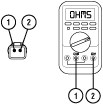
Measure resistance between 2-Way Input Shaft Speed Sensor Pin 2 and ground. Record reading(s) in table.

Reconnect 2-Way Input Shaft Speed Sensor to the Transmission Harness.
Compare reading(s) in table.
If readings are in range, replace Transmission Harness. Go to Step V
If readings are out of range, replace Input Shaft Speed Sensor. Go to Step V
| Pins | Range | Reading(s) |
|---|---|---|
| 1 to 2 | 2.0k–4.5k ohms | |
| 2 to Ground | Open Circuit (OL) |
Key off.
Disconnect 38-Way Transmission Harness Connector from the TECU.
Inspect 38-Way Connector body for damage and bent, spread, corroded or loose terminals.
Measure resistance between 38-Way Transmission Harness Connector Pin 7 and Pin 8. Record reading(s) in table.

Measure resistance between 38-Way Transmission Harness Connector Pin 7 and ground. Record reading(s) in table.

After reading is taken, reconnect 38-Way Transmission Harness Connector at the TECU.
Compare reading(s) in table.
If readings are in range, Go to Step G
If readings are out of range, Go to Step H
| Pins | Range | Reading(s) |
|---|---|---|
| 7 to 8 | 2.0k–4.5k ohms | |
| 7 to Ground | Open Circuit (OL) |
Key off.
Drain transmission of lubricant into a clean pan for re-use. Note how much lubricant comes out and if significant metal fragments appear in the oil.
Remove the 8-bolt PTO Cover.
Inspect Main Case components for any signs of damage, specifically to the main drive gear and its mating upper countershaft gear.
If damage is found or there are significant metal fragments in the oil, replace damaged, worn or failed transmission components. Go to Step V
If no damage is found, replace Input Shaft Speed Sensor and Transmission Harness. Go to Step V
Key off.
Disconnect the 2-Way Input Shaft Speed Sensor Connector.
Inspect 2-Way Connector body for damage and bent, spread, corroded or loose terminals. Also, check sensor body for cracks or visual damage.
Measure resistance between 2-Way Input Shaft Speed Sensor Pin 1 and Pin 2. Record reading(s) in table.

Measure resistance between 2-Way Input Shaft Speed Sensor Pin 2 and ground. Record reading(s) in table.

Reconnect 2-Way Input Shaft Speed Sensor to the Transmission Harness.
Compare reading(s) in table.
If readings are in range, replace Transmission Harness. Go to Step V
If readings are out of range, replace the Input Shaft Speed Sensor. Go to Step V
| Pins | Range | Reading(s) |
|---|---|---|
| 1 to 2 | 2.0k–4.5k ohms | |
| 2 to Ground | Open Circuit (OL) |
Key off.
Reconnect all connectors and verify that all components are properly installed.
Key on with engine off.
Clear fault codes using ServiceRanger.
Drive vehicle and attempt to reset the code or duplicate the previous complaint.
Check for fault codes using ServiceRanger.
If no fault codes set Active and vehicle operates properly, test complete.
If Fault Code 56 sets Active during the test drive, refer to Contact Information and contact Eaton for further diagnostics.
If a fault code other than 56 sets, troubleshoot per Fault Code Isolation Procedure Index.